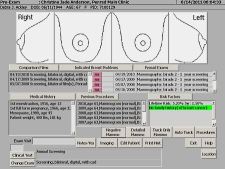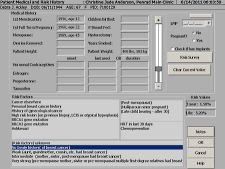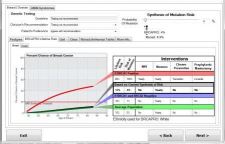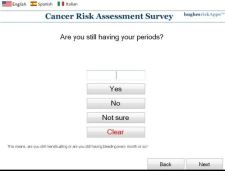![]() PenRad MIS
PenRad MIS
Overview
|
Appointment Package
|
Bone Density
|
Breast Density
|
CAD Connectivity
|
Data Migration
|
DICOM
|
Navigator
PenConnect
|
PenFetch/Plus
|
PenHL7
|
PenProfiler
|
PenWHF
|
Risk Assessment
|
Softcopy Integration
|
Voice Integration
Risk Assessment Tools
|
PenRad internally integrates the code for various risk models engines. The NCI/NSABP BCRA tool is the most common for patients and referring physicians because of web access. (LEARN MORE at www.cancer.gov/bcrisktool/).Real-time risk values are displayed on examination and patient risk screens. Values can be incorporated in the narrative report and the patient exam letter. Some regulations require the patient be notified of their breast density and be offered additional imaging evaluation if extremely dense. Additionally, PenRad can facilitate automatic custom phrases based on levels of density in the patient exam letters.Risk factors inputs come from Patient Medical and Risk History screen and from the Breast History screen by sampling previous biopsy exams or the manually entered biopsies from outside facilities.Many facilities use the life-time risk tool (<20%) as reimbursement criteria tool for recommendation of breast MRI. In the custom letter template section, a letter to the insurance provider can be generated, automatically incorporating risk factors, exam and family history as well as the risk percentage values.PenRad administrative report 1BB provides risk result values for historical exams by patient and threshold filters. |
Hughes riskApps™ Integration
PenRad can now integrate with the Hughes riskApps cancer risk model and patient survey for expanded risk assessment that can improve qualification of patients into high risk screening programs offering additional studies (i.e. breast MRI and BRCA testing). Hughes riskApps also offers expanded risk calculation assessment using additional models including breast, colon and ovarian cancer prediction. The results of these risk factors are available for the radiologist during interpretation, as well as for the clinician and genetic counselor.
The Hughes Risk Application can run on a wireless tablet or kiosk for patient surveying during office visits. Many facilities use PenRad’s incorporated risk models as the initial screening tool and use the Hughes package for elevated risk patients.
The Hughes riskApps and patient kiosk/tablet survey software connects to PenRad’s database, eliminating the need for duplicated data entry. The patient survey application can be used as a paperless survey for breast centers instead of an interactive interview with the patient.
The Hughes Risk Application provides various evaluation and clinical tools for statistics, providing clinics with the most advanced information. (LEARN MORE at www.HughesRiskApps.com.)
Background on Hughes riskApps
Originally conceived and developed by Kevin S. Hughes, MD and Sherwood S. Hughes of the Massachusetts General Hospital, Hughes Risk Apps was designed to identify and manage women at high risk for hereditary cancer. The application is the work of a consortium of the Massachusetts General Hospital, the University of Massachusetts at Lowell, and the Newton-Wellesley Hospital.
The system offers a patient-populated survey of his/ her own family history and risk data using a wireless touch tablet or kiosk PC (in various languages) or input and review by a clinical staff member. When using is wireless tablet, no patient data resides on the tablet, eliminating concern of data loss or an inadvertent HIPPA violation.
Once the survey data is received it is analyzed for BRCA1 & 2, MLH1, 2, 6 mutations as well as for breast, colorectal, endometrial and ovarian cancer risk, for 5-year and life time percentages.
In addition, the Hughes riskApps application generates a graphical pedigree of family history, recap family history, and risk calculation results in numerical and graphical formats available on screen or as a report printout. Results include output from the BayesMendel models, BRCAPRO, CLAUS, GAIL and MYRIAD models.
The BayesMendel model calculates risk for several cancer risk models, including breast, ovarian, colorectal, endometrial, and pancreatic cancers, as well as melanoma. It does this by invoking the BRCAPro, MMRPro, PancPro, and MelaPro BayesMendel risk calculation models. These risk models are jointly included in a set of software algorithms known as the BayesMendel R package, that is maintained by Dr. Parmigiani and colleagues of the Dana-Farber Cancer Institute. These algorithms take family history data such as disease occurrences in family members, genetic test result data, and tumor marker data, and calculate probabilities for genetic mutation as well as probabilities for cancer in various time periods.
|
About Hughes riskApps Clinician ApplicationThe Hughes riskApps Clinician Application provides physicians and clinic staff the ability to interact with patient data, run breast, ovarian and colorectal cancer risk calculations, print surveys with graphical pedigrees and letters for patients and referring physicians. Extended risk functionality allows for entering additional information related to genetic testing of patients and family members as well as decision support for future treatment plans of high risk patients.About Hughes riskApps Tablet ApplicationThe Hughes riskApps tablet application allows patients to navigate a questionnaire and provide answers to both family history and life style questions.The Standard questionnaire, which takes 2 to 4 minutes to complete, is a basic set of questions aimed at identifying patients who are at potentially high risk. High risk patients may then be referred to a high risk clinic program where they can answer the Risk Clinic questionnaire which takes 10 to 20 minutes to complete varying on the complexity of a patient's family history.On subsequent visits, prior survey data is pulled forward and patients are allowed to change or add information. Based on a series of internal thresholds the survey expands to collect more specific data for hereditary risk assessment when applicable. The Risk Clinic questionnaire collects more detailed information about family members, diseases, age of onset and current status. Clinicians may also enter or review the data through the clinician application during one on one interviews. |



